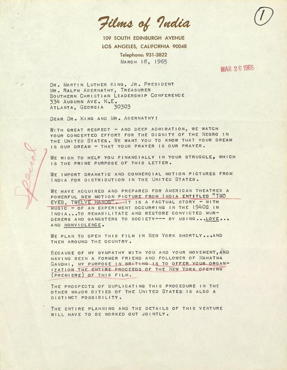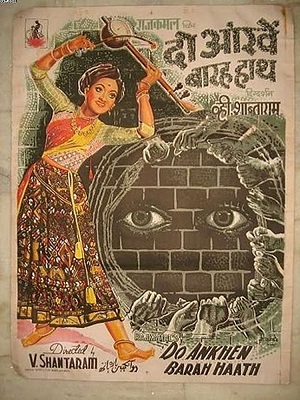This year, The Aerogram is restarting its collaboration with the South Asian American Digital Archive (SAADA), which documents and shares the history of South Asian Americans. To kick things off, we begin with a piece tied to Martin Luther King Jr. Day.
***

In 1965, Martin Luther King Jr. and Ralph Abernathy received a letter from Films of India, a Los Angeles-based organization that screened Hindi films in the United States. In the letter, Ram Bagai, president of Films of India and a former president of the Hollywood Foreign Press Association, expressed support for the U.S. civil rights movement. Bagai offered to donate all proceeds from the New York premiere of the movie Do Aankhen Barah Haath (Two Eyes, Twelve Hands) to the Southern Christian Leadership Conference, the organization King and Abernathy headed.
This letter, archived at the King Center, documents one of the ways that South Asian Americans supported the civil rights movement. Bagai clearly saw a link between civil rights for African Americans and civil rights for South Asian Americans. He wrote:
With great respect — and deep admiration, we watch your concerted effort for the dignity of the Negro in the United States. We want you to know that your dream is our dream — that your prayer is our prayer.
Bagai himself had experienced racial discrimination in the United States. As detailed in Tides, the online magazine of the South Asian American Digital Archive, he arrived in California as a young boy with his parents in 1915. Although his father Vaishno Das Bagai established a successful business, when the family tried to move into a house in Berkeley, they discovered that neighbors had locked it up to prevent them from taking residence.
“Bagai clearly saw a link between civil rights for African Americans and civil rights for South Asian Americans.”
In addition, his father, who became a naturalized U.S. citizen in 1921, was stripped of his citizenship after the 1923 Supreme Court decision in United States v. Bhagat Singh Thind, which denied South Asians citizenship due to their race. Loss of citizenship caused him to have to liquidate his property, and after being denied a U.S. passport to travel to India in 1928, he took his own life.
Given these traumatic experiences, it’s understandable why Bagai offered to lend his support to the civil rights movement. In his letter he wrote:
Because of my sympathy with you and your movement, and having been a former friend and follower of Mahatma Gandhi, my purpose in writing is to offer your organization the entire proceeds of the New York opening (premiere) of this film.

Bagai wrote that the film, Do Aankhen Barth Haath, was based on the true story of a 1940s Indian experiment that aimed to rehabilitate convicts through “love” and “nonviolence” (both terms are underlined in the original letter). The movie synopsis on IMDb describes it as “Progressive, reform-minded young warden gets permission to take six surly murderers from prison to dilapidated country farm, to rehabilitate it and themselves through hard work and kindly guidance.” Undoubtedly Bagai saw the movie’s themes of kindness, love, and nonviolence to be in keeping with the values driving King’s activism.
It’s unknown if anything came of Bagai’s offer of the movie proceeds. What has been well documented is that King admired Gandhi’s strategy of nonviolence. It was King’s focus on nonviolent civil disobedience that gave so much moral power to the civil rights movement, and it’s one of the key principles we celebrate each Martin Luther King Jr. Day.
***
Bonus SAADA documents: For first-person accounts by Indians of the horrific treatment of African Americans in the early 1900s, please check out the following two articles from 1908 and 1911. They are a sobering reminder of the evils of racial prejudice.
—“Colour Line in the United States of America and How the Negro Is Uplifting Himself Despite Odds” (1908) by Saint Nihal Sing. Among the many racial injustices described in this article, Sing writes of being told about a well-to-do African American doctor in Mississippi whose estate and car were torched by jealous white people — with no one ever held accountable.
—“Travelling Through the Country in America” (1911) by Sudhindra Bose. This article is more of a general description of America as Bose travels by train through the country, but he does write about a lynching and remarks, “A large number of Americans, it seems, think no more of shooting the negroes for pastime than they do of shooting the wild cats in the prairie.”
***
Preeti Aroon (@pjaroonfp) is a Washington, D.C.-based copy editor at National Geographic and was formerly copy chief at Foreign Policy.












